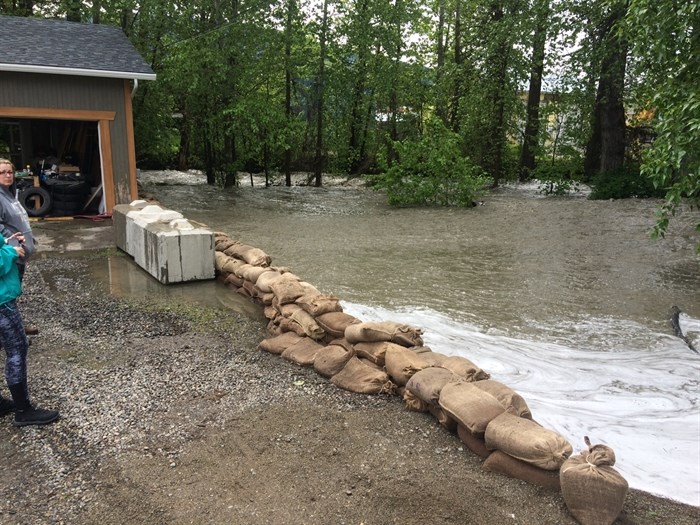
BX Creek is one of many areas that may be impacted by high Okanagan groundwater levels this spring.
Image Credit: City of Vernon
January 24, 2019 - 6:00 PM
KELOWNA - Despite a lower than average snowpack so far this winter and up to 90 days without rain in recent summers, groundwater in some Okanagan locations is at its highest levels in 30 years.
“We are currently experiencing high groundwater levels in many monitoring locations within the Okanagan,” Regional Hydrologist Nicole Pyett wrote in an email to iNFOnews.ca.
Pyett, who works for the Ministry of Forests, explained that the last two wet springs were the main causes of the soggy ground and that they will have a long term impact.
“Given the magnitude of the change above ‘average’ conditions, groundwater levels within the Okanagan will likely take a number of years to return to average conditions, even if we experience average, or lower than average, precipitation,” she wrote.
That won’t have much impact on lake levels but could still create major problems for residents.
“The groundwater is going to be much more problematic for localized flooding, like we saw in the Sportsman Bowl area last year,” Shaun Reimer, Section Head for the province’s Public Safety and Protection branch and the man responsible for controlling lake levels in the Okanagan, told iNFOnews.ca. “That sort of flooding began even prior to any significant snow melt.”
Twelve homes in the Sportsman Bowl Road area north of Oliver were evacuated last April when water washed out their road. They were kept from their homes for more than a month.
In Kelowna, groundwater had to be pumped out of the Glenmore Landfill site into nearby Roberts Lake. The city budgeted $50,000 this year to study the impact of that action and plan for the future due to high groundwater levels, Kevin Van Vliet, the city's Utility Services Manager said.
The province has dozens of wells throughout the Okanagan that monitor ground water levels. Some have records only going back three years but the Willowbrook Well, near Sportsman Bowl, has 30 years of data.
It shows great fluctuations over the years, with groundwater about 12 metres below the surface in 1990 and through the first ten years of this century. There were a couple of peaks in the mid 1980s and late 1990s when the water rose to within two to four metres of the surface.
But, in the last two springs, it rose to within a few centimetres of the surface.
It’s too early to tell if it will get as high again this spring as it’s now dropped to about six metres but, based on past records, it will take a few years to drop back to historical lows.
“The 1990s were wet. The 1970s were wet. The 1980s were dry, in general,” Reimer said. “You just see these cycles but, certainly, the 2010s have been very wet. Whether or not it’s completely due to climate change or an extension of a sort of cyclical pattern that has been going on for a long time, I can’t say.”
Other wells in the region show a great diversity in ground water levels.
One near Armstrong, for example, shows groundwater levels about two metres lower for the last 15 years than in previous decades.
Another, near Oyama on Sawmill Road in the Central Okanagan, reached record highs last year but have fallen about five metres since. Even at its peak, it was still about eight metres below the surface.
In West Kelowna, the Gill Road well peaked in 2016 at two metres below ground level, dropped 10 metres in 2017 before climbing partway back in 2018. But it only has five years of data so does not show the long-term pattern.
These are just a few of the many wells in the region. The readings are on graphs so dates and elevations can only be estimated.
Given the warm, relatively dry winter, there isn’t much of a snowpack at lower elevations – despite the heavy snowfall earlier this week.
That bodes well for those concerned about lakes flooding but the Regional District of Okanagan-Similkameen did issue a flood preparedness news release earlier this month.
“Due to high groundwater throughout the RDOS, there remains an imminent risk of flooding from rainfall events,” the release states. “Residents living in areas impacted by flooding in recent years should have a preparedness plan in place.”
The same warning can apply to any Okanagan resident where there was flooding in the past.
To contact a reporter for this story, email Rob Munro or call 250-808-0143 or email the editor. You can also submit photos, videos or news tips to the newsroom and be entered to win a monthly prize draw.
We welcome your comments and opinions on our stories but play nice. We won't censor or delete comments unless they contain off-topic statements or links, unnecessary vulgarity, false facts, spam or obviously fake profiles. If you have any concerns about what you see in comments, email the editor in the link above.
News from © iNFOnews, 2019